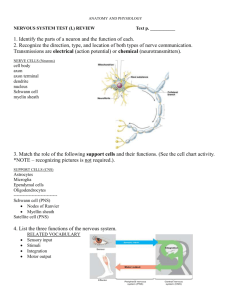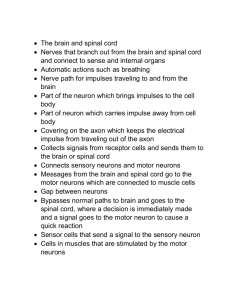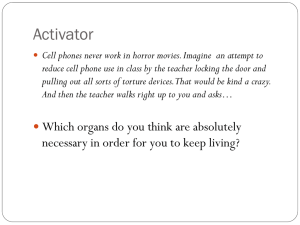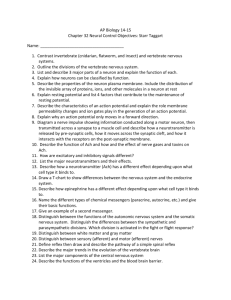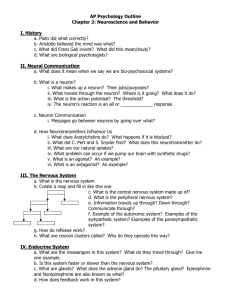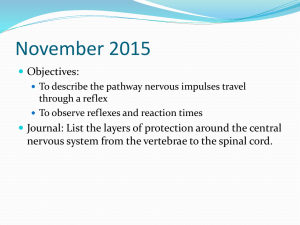The Nervous System
advertisement
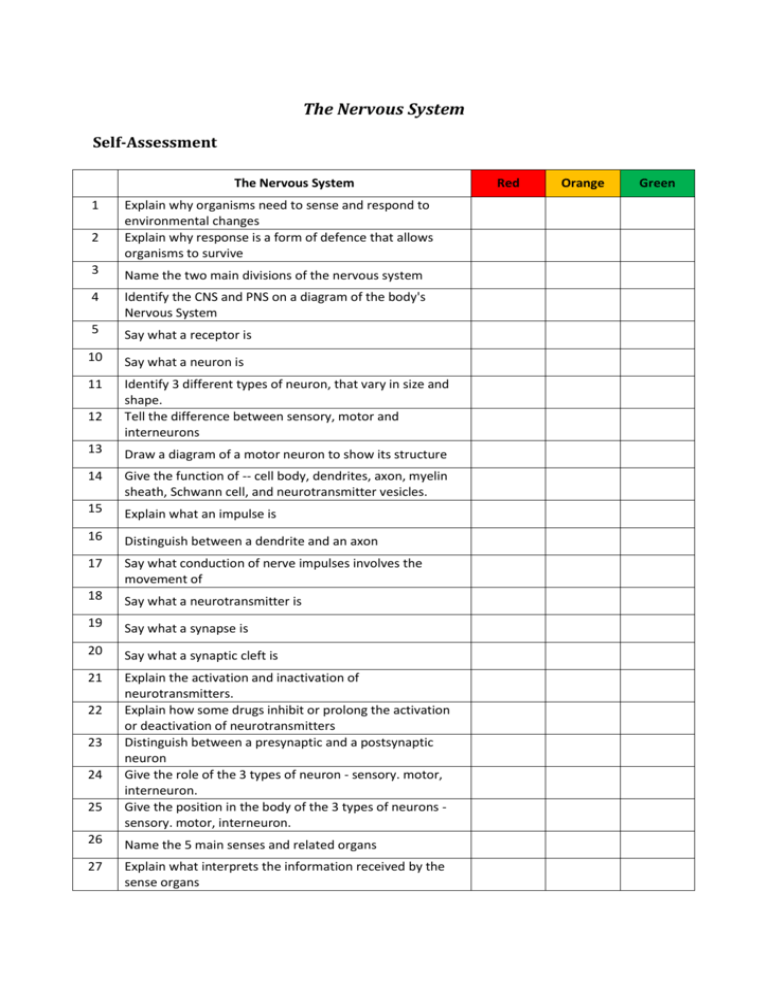
The Nervous System Self-Assessment The Nervous System 1 2 Explain why organisms need to sense and respond to environmental changes Explain why response is a form of defence that allows organisms to survive 3 Name the two main divisions of the nervous system 4 Identify the CNS and PNS on a diagram of the body's Nervous System 5 Say what a receptor is 10 Say what a neuron is 11 Identify 3 different types of neuron, that vary in size and shape. Tell the difference between sensory, motor and interneurons 12 13 Draw a diagram of a motor neuron to show its structure 14 Give the function of -- cell body, dendrites, axon, myelin sheath, Schwann cell, and neurotransmitter vesicles. 15 Explain what an impulse is 16 Distinguish between a dendrite and an axon 17 Say what conduction of nerve impulses involves the movement of 18 Say what a neurotransmitter is 19 Say what a synapse is 20 Say what a synaptic cleft is 21 Explain the activation and inactivation of neurotransmitters. Explain how some drugs inhibit or prolong the activation or deactivation of neurotransmitters Distinguish between a presynaptic and a postsynaptic neuron Give the role of the 3 types of neuron - sensory. motor, interneuron. Give the position in the body of the 3 types of neurons sensory. motor, interneuron. 22 23 24 25 26 Name the 5 main senses and related organs 27 Explain what interprets the information received by the sense organs Red Orange Green 28 Name the main parts of the EYE 29 Give the function of each main part of the eye 30 Explain what short-sightedness means 31 Draw a diagram of the eye with light rays to show the problem of short sight 32 Show how a lens can be used to correct short sight 33 Explain what long-sightedness means 34 Draw a diagram of the eye with light rays to show the problem of long sight 35 Show how a lens can be used to correct long sight 36 Distinguish between a convex and a concave lens 37 Name the main parts of the EAR 38 Give the function of each main part of the ear 39 Name a hearing defect 40 Explain a possible hearing disability as a result of excessive noise levels. 41 Explain a corrective measure for a hearing defect 42 Use a model/diagram of the SKIN to show how it functions as a sense organ. Use a model of the BRAIN to show its major parts in relation to function. Give the location and function of the following parts of the brain: cerebrum, hypothalamus, pituitary gland, cerebellum, and medulla oblongata. 43 44 45 Identify the main parts of a cross-section of the spinal cord 46 Distinguish between white matter and grey matter 47 Give the function of cerebrospinal fluid 48 Give the function of the meninges 49 Explain what meningitis is 50 Distinguish between dorsal and ventral roots that project from the spinal cord. 51 Name a nervous system disorder 52 For paralysis, give 1 possible cause, prevention, and treatment. For Parkinson's disease, give 1 possible cause, prevention, and treatment. Show the location of nerve fibres and cell bodies in the Peripheral nervous system: 53 54 55 Identify cell bodies in the CNS and in ganglia 56 Explain what a ganglion is 57 Explain the role, structure and mechanisms of the reflex arc/action. Use a prepared slide to identify, draw and label the main parts of a T.S. of the spinal cord. 58 59 Write a brief note on paralysis or Parkinson’s disease. 60 Describe a simple experiment to demonstrate reflex action

